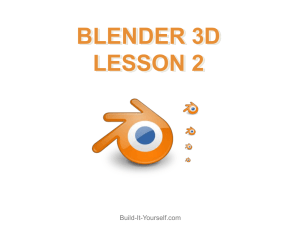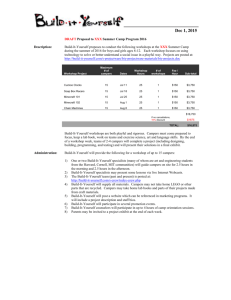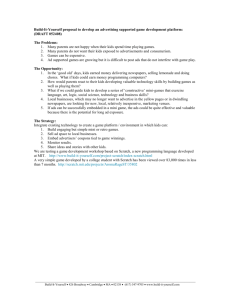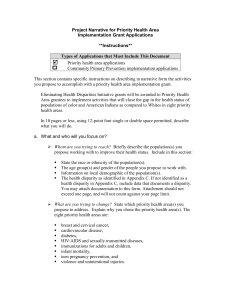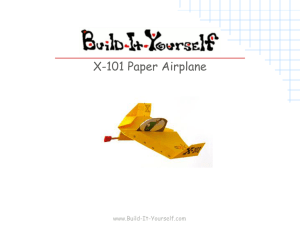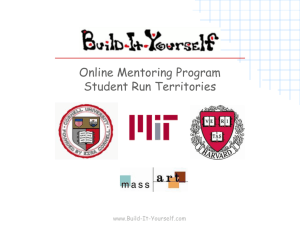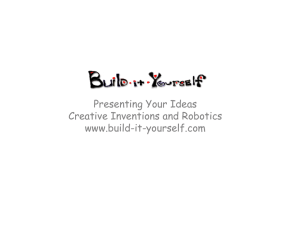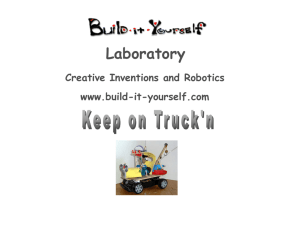Clock Design Project - Build-It
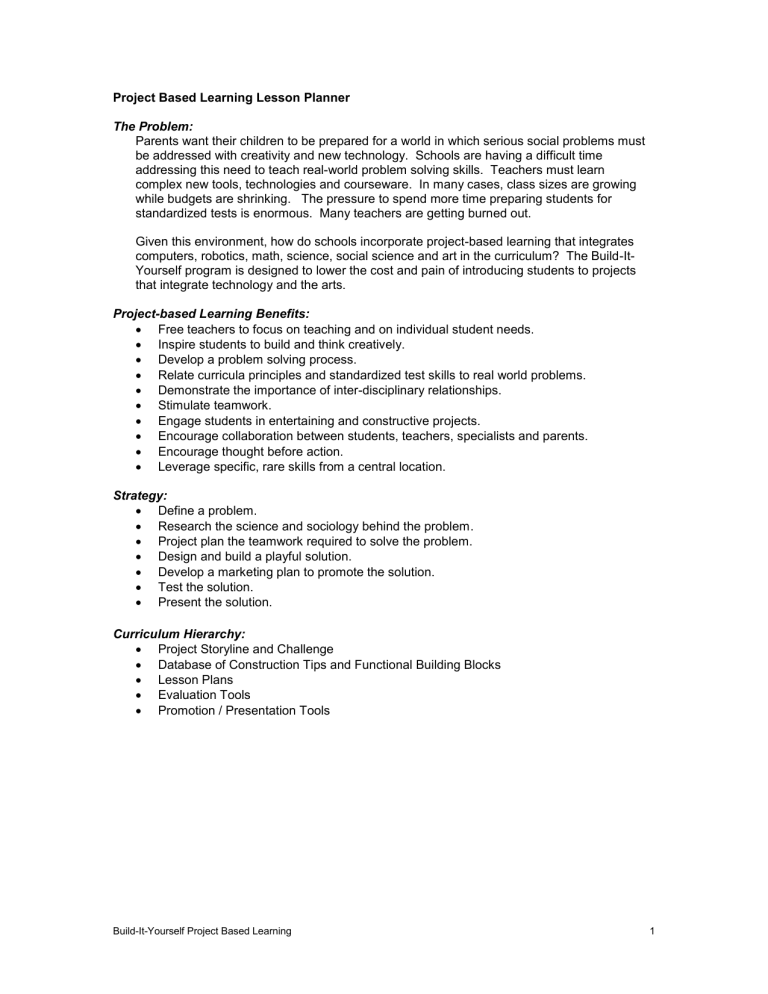
Project Based Learning Lesson Planner
The Problem:
Parents want their children to be prepared for a world in which serious social problems must be addressed with creativity and new technology. Schools are having a difficult time addressing this need to teach real-world problem solving skills. Teachers must learn complex new tools, technologies and courseware. In many cases, class sizes are growing while budgets are shrinking. The pressure to spend more time preparing students for standardized tests is enormous. Many teachers are getting burned out.
Given this environment, how do schools incorporate project-based learning that integrates computers, robotics, math, science, social science and art in the curriculum? The Build-It-
Yourself program is designed to lower the cost and pain of introducing students to projects that integrate technology and the arts.
Project-based Learning Benefits:
Free teachers to focus on teaching and on individual student needs.
Inspire students to build and think creatively.
Develop a problem solving process.
Relate curricula principles and standardized test skills to real world problems.
Demonstrate the importance of inter-disciplinary relationships.
Stimulate teamwork.
Engage students in entertaining and constructive projects.
Encourage collaboration between students, teachers, specialists and parents.
Encourage thought before action.
Leverage specific, rare skills from a central location.
Strategy:
Define a problem.
Research the science and sociology behind the problem.
Project plan the teamwork required to solve the problem.
Design and build a playful solution.
Develop a marketing plan to promote the solution.
Test the solution.
Present the solution.
Curriculum Hierarchy:
Project Storyline and Challenge
Database of Construction Tips and Functional Building Blocks
Lesson Plans
Evaluation Tools
Promotion / Presentation Tools
Build-It-Yourself Project Based Learning 1
Project Based Learning Lesson Planner (Clock Project)
Lesson #1
Questions:
What are the most interesting clocks you have seen?
What is the history of clocks?
When must we keep good track of time?
What are your favorite “Time” quotes?
How would you describe a clock that you would like to build in 5 workshops?
What are ugly vs. cool ways to present your ideas?
How do you draw or characterize different expressions: happy, cute, goofy, stupid?
Actions:
Start a lab book.
Document the goal.
Document ugly and cool presentations.
Design nut heads
Lesson #2
Questions:
Review idea presentation and drawing caricatures.
What is the goal and theme of our clock?
How can you color something to make it look 3D?
What materials that are used for something other than what they were designed for?
Actions:
Document the goal.
Document tool rules.
Document coloring tricks
Draw Lab Book Cover.
Team 1 - Design clock numbers
Team 2 - Build the clock mechanism
Team 3 - Build motion modules
Team 4 - Design Clock Sign
Lesson #3
Questions:
What is the goal and theme of our clock?
Critique Nutheads and Numbers
What are the 5 BIY tool rules.
How can you color something to make it look 3D?
Why is the presentation of ideas as important as the idea?
Gear ratios. (show turtle and hare physics)
How do you decrease speed?
How do you increase torque or the ability to move a heavy object?
Actions:
Document the goal.
Document tool rules.
Document gear up and gear down.
Build-It-Yourself Project Based Learning 2
Build-It-Yourself Project Based Learning 3
Project Based Learning Lesson Planner (For all Project Challenges)
Lesson #1
Objectives: Students will understand the importance of debating social issues, building on others’ ideas and focusing on a solution.
Social studies and presentation skills will be exercised.
Thoughts: Discuss the importance, pros and cons of a social issue.
(Appendix 1, Lesson 1)
Why is it important to present an idea clearly, concisely and convincingly?
A good idea may never benefit anyone if it is not presented well.
Show examples.
What are reasonable solutions and goals?
Doable and affordable in a certain time period
Why are lab books kept?
To make editing a solution manageable
To inform others
Show examples
To remind you of construction tips in the future
Action: Start a Lab Book.
Document a problem to be solved and possible solutions.
(Appendix 1, Lesson 1)
Document examples of concepts that are presented well and presented poorly.
Build-It-Yourself Project Based Learning 4
Project Based Learning Lesson Planner (For all Modules)
Lesson #2
Objectives: Students will understand the value of setting guidelines and teamwork.
Students will understand the science behind the social issue.
Organizational and creative skills will be exercised.
Thoughts: State clearly the problem, solution and goals on which we propose to focus.
Probe the science behind the social issue.
(See Appendix 1, Lesson 2)
When does teamwork make a difference?
What great accomplishments required teamwork?
What great accomplis hments required only one person’s effort?
Why is it important to follow guidelines and rules?
Safety
Compatibility
What are the disadvantages of rules and guidelines?
Restricts creativity and innovation
What is a project plan and why is it valuable?
Estimates resources and time required to meet goals
Monitors progress
Action: Exercise the science behind the social issue.
Set up teams and responsibilities.
(See Appendix 1, Lesson 2)
Document guidelines.
Identify tasks and estimate times to complete.
Build-It-Yourself Project Based Learning 5
Project Based Learning Lesson Planner (For all Modules)
Lesson #’s 2,3,4 – Marketing Team
Objectives: All students will understand the science behind the problem and its solution.
Marketing students will understand how to profile and quantify an audience and how to address their interests.
Construction students will focus on creative use of materials.
Control students will edit a web site.
Analysis, writing, graphic design, construction, math, research and logic skills will be exercised.
Thoughts: State clearly the problem, solution and goals on which we propose to focus.
Review Project Plan progress.
Probe the science behind the problem and its solution. (See lesson plan for specific projects.)
Appendix 1 , the
What are key characteristics of a target market?
How is a target market quantified?
How is the value of a product determined?
Action:
How is one product differentiated from another?
What does it cost to win a customer?
Specify functionality
Profile and quantify a target market
Document how a solution benefits a target market. (See plan for specific projects.)
Appendix 1 , the lesson
Compare solutions.
Write copy and design ads that promotes a solution for various media.
POS displays
Newspaper
Radio
Internet
Research how much various selling strategies cost.
Calculate how much it will cost to win a customer.
Update project management site.
Coordinate ideas with other teams.
Build-It-Yourself Project Based Learning 6
Action:
Project Based Learning Lesson Planner (For all Modules)
Lesson #’s 2,3,4 – Construction Team
Objectives: All students will understand the science behind the problem and its solution.
Marketing students will understand how to profile and quantify an audience and how to address their interests.
Construction students will focus on creative use of materials.
Control students will edit a web site.
Analysis, writing, graphic design, construction, math, research and logic skills will be exercised.
Thoughts: State clearly the problem, solution and goals on which we propose to focus.
Review Project Plan progress.
Probe the science behind the problem and its solution. (See lesson plan for specific projects.)
Appendix 1 , the
How many different materials exist in popular products?
You have two rotating shafts. How many ways can you use gears and pulleys to make one shaft drive the other?
What is the impact of weight on a design?
What is the minimum number of LEGO pieces required to get one shaft to drive a
2 nd shaft?
What is the minimum number of LEGO pieces required for the above device if your goal is to make it still functional if it is dropped from a table to the floor?
How many times must a mechanism work without failing?
Review Constructopedia mechanisms. http://www.build-it-yourself.com /constructopedia
What are the advantages of building a solution from modular components?
Break down the solution into reusable, single function components.
Build the components.
Explain how the components relate to the social issue being addressed.
(See Appendix 1 , the lesson plan for specific projects.)
Update project management site.
Coordinate ideas with other teams.
Build-It-Yourself Project Based Learning 7
Project Based Learning Lesson Planner (For all Modules)
Lesson #’s 2,3,4 – Control Team
Objectives: All students will understand the science behind the problem and its solution.
Marketing students will understand how to profile and quantify an audience and how to address their interests.
Construction students will focus on creative use of materials.
Control students will edit a web site.
Analysis, writing, graphic design, construction, math, research and logic skills will be exercised.
Thoughts: State clearly the problem, solution and goals on which we propose to focus.
Review Project Plan progress.
Probe the science behind the problem and its solution. (See lesson plan for specific projects.)
Appendix 1 , the
What is the difference between compiled code and uncompiled code?
What is the hardware / software architecture of the RCX system?
What are the commands available?
Action:
Analyze sample code.
What are the advantages of building a solution from modular components?
Break down the solution into reusable, single function components.
Explain how the components relate to the social issue being addressed.
(See Appendix 1 , the lesson plan for specific projects.)
Design a flow chart that shows the logic behind the functionality.
Edit the Project Management Web Page to document project progress.
Write RCX code that controls the mechanical mechanisms as specified.
Set up a test procedure.
Update project management site.
Coordinate ideas with other teams.
Build-It-Yourself Project Based Learning 8
Project Based Learning Lesson Planner (For all Modules)
Lesson #’s 5 – Marketing Team
Objectives: All students will test and edit their solutions.
All students will define, predict and test reliability.
All students will present their solutions.
Marketing students will understand how to forecast the effect of marketing programs
Construction students will define test procedures and measure reliability.
Control students will define test procedures and measure reliability.
Thoughts:
Action:
Logic, state diagrams, statistics, and presentation skills will be exercised.
State clearly the problem, solution and goals on which we propose to focus.
Review Project Plan progress.
How can feedback be measured?
How can marketing costs be justified?
What are characteristics of effective presentations?
What are characteristics of ineffective presentations?
Conduct tests of marketing programs.
Collect, analyze and summarize feedback.
Edit marketing programs and execute them.
Update project management site.
Coordinate ideas with other teams.
Build-It-Yourself Project Based Learning 9
Project Based Learning Lesson Planner (For all Modules)
Lesson # 5 – Construction Team
Objectives: All students will test and edit their solutions.
All students will define, predict and test reliability.
All students will present their solutions.
Marketing students will understand how to forecast the effect of marketing programs
Construction students will define test procedures and measure reliability.
Control students will define test procedures and measure reliability.
Thoughts:
Action:
Logic, state diagrams, statistics, and presentation skills will be exercised.
State clearly the problem, solution and goals on which we propose to focus.
Review Project Plan progress.
How is reliability defined?
How can feedback be measured?
How are all state conditions anticipated?
What are characteristics of effective presentations?
What are characteristics of ineffective presentations?
Conduct reliability tests.
Collect, analyze and summarize test results.
Edit construction to optimize solution.
Update project management site.
Coordinate ideas with other teams.
Build-It-Yourself Project Based Learning 10
Project Based Learning Lesson Planner (For all Modules)
Lesson # 5 – Control Team
Objectives: All students will test and edit their solutions.
All students will define, predict and test reliability.
All students will present their solutions.
Marketing students will understand how to forecast the effect of marketing programs
Construction students will define test procedures and measure reliability.
Control students will define test procedures and measure reliability.
Thoughts:
Action:
Logic, state diagrams, statistics, and presentation skills will be exercised.
State clearly the problem, solution and goals on which we propose to focus.
Review Project Plan progress.
How is reliability defined?
How can feedback be measured?
How are all state conditions anticipated?
What are characteristics of effective presentations?
What are characteristics of ineffective presentations?
Conduct reliability tests.
Collect, analyze and summarize test results.
Edit construction to optimize solution.
Update project management site.
Coordinate ideas with other teams.
Build-It-Yourself Project Based Learning 11
APPENDIX 1
Simulate what happens in your body when you get drunk.
http://www.build-it-yourself.com/glts
Module 1: Bionic Boozer--Alcohol and Your Body
Lessons:
1) What is alcohol?
2) What happens when you drink? How does alcohol get into your body?
3) Why do you feel drunk?
4) How do you get sober?
5) Putting it together-->Bionic Boozer
Lesson 1: What is Alcohol?
Thoughts:
1. Name as many different forms of alcoholic beverage that you can.
Beer, wine, hard liquor, antifreeze, mouthwash, listerine, nail polish remover. Related to exposure at home, marketing on TV, magazines, billboards, peer pressure. Draw from social studies, english, art backgrounds
2. Where does it come from?
Fermentation. Yeast/fungi and the lactic acid cycle. Draw from Biology and science coursework.
3. Where does it go?
Into your belly, through the portal circulation into your liver and then the blood stream.
Intro to the circulatory system. Draw on biology and anatomy coursework.
4. Why do you drink?
Peer pressure issues. Is it common? Is it cool? Who has had a drink before? Start dialogue. Focuses on group dynamics and high school "tribe" mentality. What factors will break down immature prejudices and allow kids to welcome input from one another?
How will teachers be able to facilitate this process?
Actions:
1. Come up with a substance in real life that can represent alcohol and its carrier substances
2. Write / draw a clear, concise, compelling ans wer to the question, “What is alcohol?”
Build-It-Yourself Project Based Learning 12
Lesson 2: What happens when you drink?
Thoughts:
1. Where does the alcohol go?
Down the pipe. Mouth to stomach.
2. What happens after it gets there?
Absorbed by the stomach and small intestine
3. How does it get to the rest of your body?
The information superhighway--> your blood
Actions:
1. Design / describe a mechanical simulation for a stomach.
2. Can you think of a way to separate the alcohol from its carrier?
3. What kind of sensor can you build to see if the Bionic Boozer is drinking alcohol or not?
Lesson 3: Why do you feel drunk?
Thoughts:
1. After alcohol gets into the blood stream, where does it go? (Heart, brain (neuro/CNS), kidneys, skin, GI)
2. Heart - Increases then decreases heart rate, eventually causes heart failure
3. Brain - Stimulant/depressant, diminished inhibition
4. Kidneys - Diuretic
5. Skin - Vasodilatation
6. GI - Nausea, gastritis, ulcer disease, cirrhosis, liver failure
7. Sexuality - Increased arousal, decreased inhibition, decreased function
8. BAL - Describe and explain the blood alcohol level
9. What is legally drunk? - BAL 0.08.
Actions:
1. Finish the stomach
2. Build a sensor to measure how much alcohol Bionic Boozer's blood stream sees when he drinks
3. Focus on the heart - build a heart out of materials
Build-It-Yourself Project Based Learning 13
Lesson 4: How do you get sober?
Thoughts:
1. What organ detoxifies your blood? The liver.
2. How is the liver attached to the circulation? Sits in between the stomach and the heart
3. How long does it take the liver to process one serving of alcohol? About an hour. BAL decreases approximately 0.01 percent per deciliter per hour.
Actions:
1. Build a liver
2. How can you attach the liver and the stomach?
3. What happens to the heart when you drink? How can you make the heart see the BAL?
Lesson 5: Put it together --> Bionic Boozer
Thoughts:
1. Reiteration on the circulatory system. What is the common thread that lets your body see the effects of alcohol? The blood stream
2. What is the BAL? What is drunk? Blood alcohol level. 0.08.
3. What are some things that happen when you're drunk? Disinhibition, flushing, increased heart rate, nausea, vomiting, coma, death
Actions:
1. Put Bionic Boozer together
2. Get Bionic Boozer drunk
3. Let Bionic Boozer get sober
4. Design your own drunk behavior
Build-It-Yourself Project Based Learning 14
